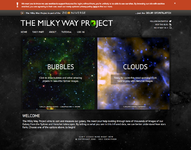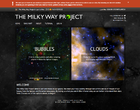The Milky Way Project
Cs Portal > List of citizen science projects > The Milky Way Project - (2013/11/14)
IDENTIFICATION
- Beta start date : N/A
- End date :
- Natural sciences > astronomy, astrophysics (space)
- Others in the same subject areas: Air Quality with Biomarkers, Andromeda Project, Bat detective, Budburst... further results
- Others projects about space: Andromeda Project, Galaxy Zoo, Solar Stormwatch, Space Warps
⇳ Description We're asking you to help us find and draw circles on infrared image data from the Spitzer Space Telescope. Understanding the material that we see in these images helps scientists to learn how stars form and how our galaxy changes and evolves with time. ➠ Purpose The Milky Way Project is currently working with data taken from the Galactic Legacy Infrared Mid-Plane Survey Extraordinaire (GLIMPSE) and the Multiband Imaging Photometer for Spitzer Galactic Plane Survey (MIPSGAL). We aim to bring you a host of interesting science problems as time goes by, and to begin with we're looking for bubbles. These bubbles are part of the life cycle of stars. Some bubbles have already been found - by the study that inspired this project - but we want to find more! By finding more, we will build up a comprehensive view of not only these bubbles, but our galaxy as a whole. We're asking you to help us map star formation in our galaxy. ? Research question The bubbles you see in this project are sometimes complete, and round, but often not. There are a great many bubbles that look like they have burst or faded away - or been disrupted by other bubbles. You can help us in this area by identifying bursting or distorted bubbles and figuring out the angle at which they burst or the eccentricity of their shape. This information will allow us to reconstruct bubbles to see how it evolved and grew. Maybe the bubble ran out of material, or maybe there is something stranger afoot!
TEAM
University of Oxford
Project team page http://www.milkywayproject.org/team Leader: Institution: University of Oxford Partner institutions: Adler Planetarium, Jeremiah Horrocks, Herschel Institute, Spitzer Space Telescope, HiGal Contact: http://www.milkywayproject.org/contact
USER TASKS
CONTRIBUTION TYPE:
PARTICIPATION TYPOLOGY:
GAMING GENRE NONE
GAMING ELEMENTS: NONE
◉ Tasks description
⤯ Interaction with objects
▣ Interface
- Data type to manipulate:
- interface enjoyment:
- Interface usability:
GUIDANCE
- Tutorial: Somewhat
- Peer to peer guidance: Somewhat
- Training sequence: Somewhat
- Individual performance: Somewhat
- Collective performance: Somewhat
- Research progress: Somewhat
❂ Feedback and guidance description
COMMUNITY
- Communication:
- Social Network: N/A
- Member profiles:: N/A
- Member profile elements:
- Main news site:
- Frequency of project news updates: N/A
- Type of events:
- Frequency of events :
⏣ Community description
- Community size (volounteers based)
- Role:
- Interaction form:
- Has official community manager(s): N/A
- Has team work N/A
- Other:
- Community led additions:
Other information
PROJECT
Url:http://www.milkywayproject.org/
Start date:
End date:
Infrastructure: Zooniverse
TEAM
Official team page:http://www.milkywayproject.org/team
Leader:
Institution: University of Oxford
Partner institutions: Adler Planetarium, Jeremiah Horrocks, Herschel Institute, Spitzer Space Telescope, HiGal
Contact: http://www.milkywayproject.org/contact
Main location: University of Oxford
PROJECT DEFINITION
Subject
Natural sciences > astronomy, astrophysics (space)
Description
We're asking you to help us find and draw circles on infrared image data from the Spitzer Space Telescope. Understanding the material that we see in these images helps scientists to learn how stars form and how our galaxy changes and evolves with time.
Purpose.
The Milky Way Project is currently working with data taken from the Galactic Legacy Infrared Mid-Plane Survey Extraordinaire (GLIMPSE) and the Multiband Imaging Photometer for Spitzer Galactic Plane Survey (MIPSGAL). We aim to bring you a host of interesting science problems as time goes by, and to begin with we're looking for bubbles. These bubbles are part of the life cycle of stars. Some bubbles have already been found - by the study that inspired this project - but we want to find more! By finding more, we will build up a comprehensive view of not only these bubbles, but our galaxy as a whole. We're asking you to help us map star formation in our galaxy.
Research question.
The bubbles you see in this project are sometimes complete, and round, but often not. There are a great many bubbles that look like they have burst or faded away - or been disrupted by other bubbles. You can help us in this area by identifying bursting or distorted bubbles and figuring out the angle at which they burst or the eccentricity of their shape. This information will allow us to reconstruct bubbles to see how it evolved and grew. Maybe the bubble ran out of material, or maybe there is something stranger afoot!
ABOUT PARTICIPANT TASKS
.
.
| Grey typology | Participation typology | Contribution type: | ||||||||||||||||||||||||||||
|---|---|---|---|---|---|---|---|---|---|---|---|---|---|---|---|---|---|---|---|---|---|---|---|---|---|---|---|---|---|---|
|
|
|
||||||||||||||||||||||||||||
| Gaming | ||||||||||||||||||||||||||||||
| Genre: | Gaming elements: | |||||||||||||||||||||||||||||
| Interface | ||||||||||||||||||||||||||||||
| Data type to manipulate: | interface enjoyment: Interface usability: |
Member profiles::N/A Member profile elements: |
||||||||||||||||||||||||||||
ABOUT GUIDANCE AND FEEDBACK
| Guidance | Feedback on | ||||||||||||
|---|---|---|---|---|---|---|---|---|---|---|---|---|---|
|
|
.
COMMUNITY
| Tools | News & Events |
|---|---|
|
Communication: |
Main news site: |
| Community description | |
|
Community size (volounteers based): |
|
Other information about community:
Community led additions:
OTHER PROJECT INFORMATION
Capture d’écran 2013-11-14 à 15.26.38.png No
http://www.milkywayproject.org/team
University of Oxford http://www.milkywayproject.org/contact
No astronomy, astrophysics Natural sciences space The Milky Way Project is currently working with data taken from the Galactic Legacy Infrared Mid-Plane Survey Extraordinaire (GLIMPSE) and the Multiband Imaging Photometer for Spitzer Galactic Plane Survey (MIPSGAL). We aim to bring you a host of interesting science problems as time goes by, and to begin with we're looking for bubbles. These bubbles are part of the life cycle of stars. Some bubbles have already been found - by the study that inspired this project - but we want to find more! By finding more, we will build up a comprehensive view of not only these bubbles, but our galaxy as a whole. We're asking you to help us map star formation in our galaxy. The bubbles you see in this project are sometimes complete, and round, but often not. There are a great many bubbles that look like they have burst or faded away - or been disrupted by other bubbles. You can help us in this area by identifying bursting or distorted bubbles and figuring out the angle at which they burst or the eccentricity of their shape. This information will allow us to reconstruct bubbles to see how it evolved and grew. Maybe the bubble ran out of material, or maybe there is something stranger afoot!
The Milky Way Project
, other:
Thinking: no
Computing: no
Sensing: no
Gaming: no
N/A N/A N/A N/A N/A N/A
N/A
N/A
N/A
N/A
N/A
Bibliography
| BIBLIOGRAPHY |



